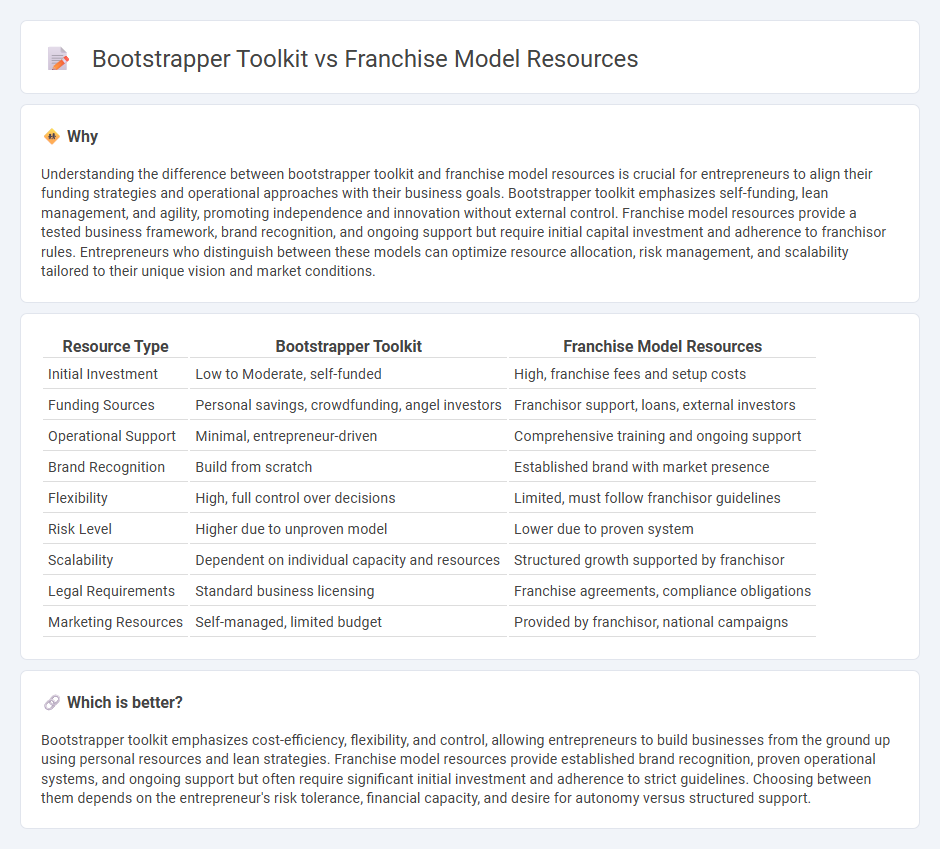
Bootstrappers rely on self-funding and lean strategies to build their businesses from the ground up, emphasizing flexibility and control over operations. Franchise models offer established brand recognition, proven business systems, and ongoing support, reducing startup risks and accelerating market entry. Explore detailed comparisons of bootstrapper toolkits and franchise resources to determine the best entrepreneurial path for your goals.
Why it is important
Understanding the difference between bootstrapper toolkit and franchise model resources is crucial for entrepreneurs to align their funding strategies and operational approaches with their business goals. Bootstrapper toolkit emphasizes self-funding, lean management, and agility, promoting independence and innovation without external control. Franchise model resources provide a tested business framework, brand recognition, and ongoing support but require initial capital investment and adherence to franchisor rules. Entrepreneurs who distinguish between these models can optimize resource allocation, risk management, and scalability tailored to their unique vision and market conditions.
Comparison Table
| Resource Type | Bootstrapper Toolkit | Franchise Model Resources |
|---|---|---|
| Initial Investment | Low to Moderate, self-funded | High, franchise fees and setup costs |
| Funding Sources | Personal savings, crowdfunding, angel investors | Franchisor support, loans, external investors |
| Operational Support | Minimal, entrepreneur-driven | Comprehensive training and ongoing support |
| Brand Recognition | Build from scratch | Established brand with market presence |
| Flexibility | High, full control over decisions | Limited, must follow franchisor guidelines |
| Risk Level | Higher due to unproven model | Lower due to proven system |
| Scalability | Dependent on individual capacity and resources | Structured growth supported by franchisor |
| Legal Requirements | Standard business licensing | Franchise agreements, compliance obligations |
| Marketing Resources | Self-managed, limited budget | Provided by franchisor, national campaigns |
Which is better?
Bootstrapper toolkit emphasizes cost-efficiency, flexibility, and control, allowing entrepreneurs to build businesses from the ground up using personal resources and lean strategies. Franchise model resources provide established brand recognition, proven operational systems, and ongoing support but often require significant initial investment and adherence to strict guidelines. Choosing between them depends on the entrepreneur's risk tolerance, financial capacity, and desire for autonomy versus structured support.
Connection
Bootstrapper toolkits provide entrepreneurs with essential low-cost resources and strategies to launch ventures independently, emphasizing financial prudence and self-sufficiency. Franchise model resources offer structured operational frameworks, brand recognition, and ongoing support, enabling entrepreneurs to scale businesses rapidly with proven systems. The connection lies in combining bootstrapper resourcefulness with franchise support, allowing entrepreneurs to minimize initial investments while leveraging established business models for sustainable growth.
Key Terms
Franchise Agreement
The Franchise Agreement is a crucial component that distinguishes franchise model resources from bootstrapper toolkits, providing a legal framework that defines franchisee and franchisor rights, obligations, and operational guidelines. Franchise model resources emphasize standardized procedures and brand consistency enforced through the agreement, while bootstrapper toolkits typically lack formal contracts, relying instead on flexible, founder-driven agreements. Explore the key elements and benefits of Franchise Agreements to understand how they protect investments and ensure business scalability.
Operating Manual
A comprehensive operating manual serves as a cornerstone in both franchise model resources and bootstrapper toolkits, providing detailed procedures, brand standards, and operational guidelines that ensure consistency and efficiency. Franchise manuals are typically more extensive, incorporating franchisor-mandated protocols and regulatory compliance, whereas bootstrapper manuals tend to be leaner, emphasizing adaptability and cost-effective practices. Explore our resources to understand how an optimized operating manual can drive success in your business model.
Personal Savings
Personal savings play a critical role in bootstrapping, providing founders with immediate capital to sustain operations without external dependencies. Franchise model resources typically require less personal saving upfront since franchisors often provide established brand value, marketing, and operational support. Explore further to understand how personal savings influence growth strategies in both business models.
Source and External Links
Franchise Resource Directory - Comprehensive resource hub offering guidance on accounting, advertising, customer relations, financing, real estate, HR, technology, and legal assistance for franchise success.
Franchise Resources | FranNet - Educational modules, tools like readiness assessments, funding pre-qualification, webinars, and success stories designed to support prospective and current franchise owners.
Types of Franchise Models Explained - HigherVisibility - Detailed explanation of franchise models including product distribution and manufacturing franchise models, highlighting operational and business structure differences.
 dowidth.com
dowidth.com